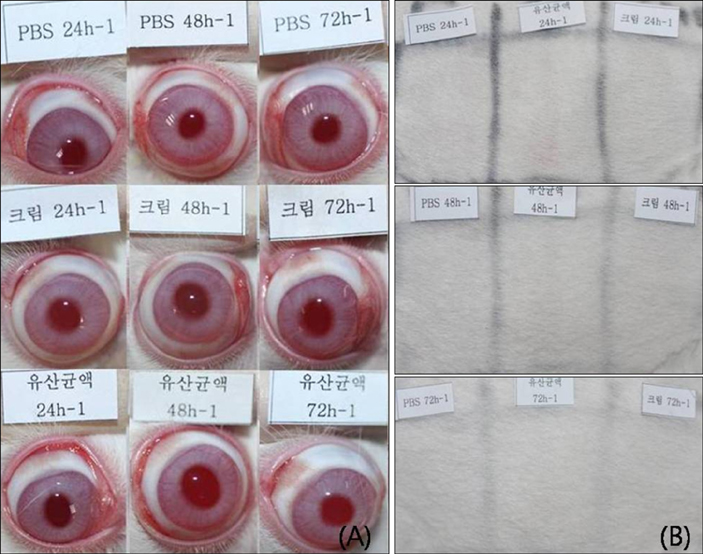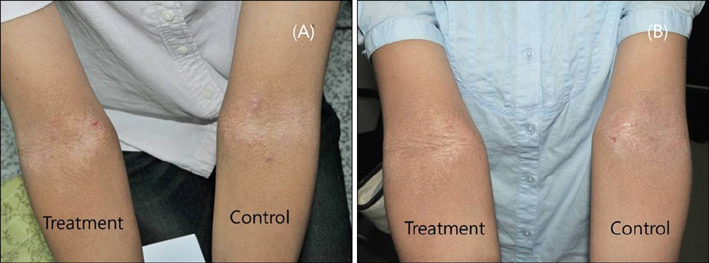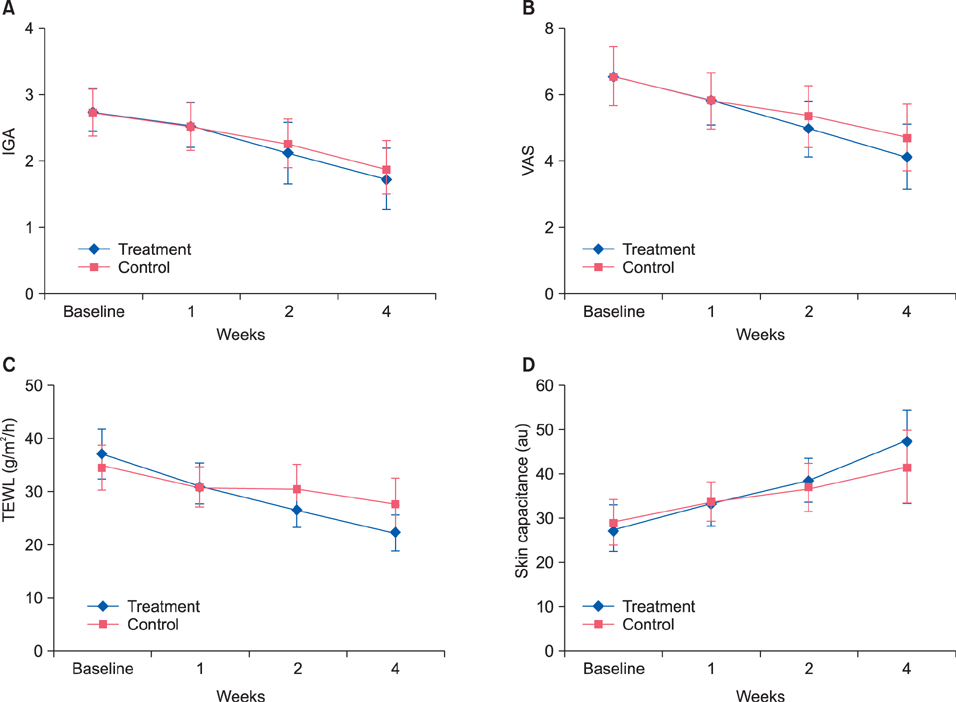Ann Dermatol.
2014 Apr;26(2):150-155. 10.5021/ad.2014.26.2.150.
Effect of Emollients Containing Vegetable-Derived Lactobacillus in the Treatment of Atopic Dermatitis Symptoms: Split-Body Clinical Trial
- Affiliations
-
- 1Department of Dermatology, Chungnam National University School of Medicine, Daejeon, Korea. joon@cnu.ac.kr
- 2Department of Applied Microbiology and Biotechnology, Yeungnam University, Gyeongsan, Korea.
- KMID: 2171648
- DOI: http://doi.org/10.5021/ad.2014.26.2.150
Abstract
- BACKGROUND
Atopic dermatitis (AD) patients suffer from xerosis. Proper skin care, including the use of emollients, may help improve xerosis and minimize disease exacerbation. Lactobacillus sakei probio 65, isolated from the Korean vegetable-based product kimchi, can decrease interleukin 4 and immunoglobulin E levels and inhibit Staphylococcus aureus. Moreover, it has reportedly shown positive dermatological effects in both animal and clinical studies.
OBJECTIVE
To compare the effects of an emollient that contains Lactobacillus (treated) with a normal emollient (control) on AD.
METHODS
This double-blind, randomized, split-body clinical trial involved 28 patients with AD. The patients applied the Lactobacillus-containing emollient on one side of their body and the control emollient on the other side twice daily for 4 weeks. Trans-epidermal water loss (TEWL) and skin capacitance were evaluated and investigator global assessment and the visual analogue scale (VAS) were administered on weeks 0, 1, 2, and 4.
RESULTS
The treated sides had significantly lower TEWL and VAS values and significantly higher skin capacitance values over time than the control sides.
CONCLUSION
Topical application of Lactobacillus-containing emollients may improve the skin permeability of patients with AD.
Keyword
MeSH Terms
Figure
Cited by 1 articles
-
Effects of Emollient Containing Bee Venom on Atopic Dermatitis: A Double-Blinded, Randomized, Base-Controlled, Multicenter Study of 136 Patients
Chung Eui You, Seok Hoon Moon, Kwang Hoon Lee, Kyu Han Kim, Chun Wook Park, Seong Joon Seo, Sang Hyun Cho
Ann Dermatol. 2016;28(5):593-599. doi: 10.5021/ad.2016.28.5.593.
Reference
-
1. Leung DY, Bieber T. Atopic dermatitis. Lancet. 2003; 361:151–160.
Article2. Leung DY, Hanifin JM, Charlesworth EN, Li JT, Bernstein IL, Berger WE, et al. Work Group on Atopic Dermatitis. Disease management of atopic dermatitis: a practice parameter. Joint Task Force on Practice Parameters, representing the American Academy of Allergy, Asthma and Immunology, the American College of Allergy, Asthma and Immunology, and the Joint Council of Allergy, Asthma and Immunology. Ann Allergy Asthma Immunol. 1997; 79:197–211.3. Hanifin JM, Cooper KD, Ho VC, Kang S, Krafchik BR, Margolis DJ, et al. Guidelines of care for atopic dermatitis, developed in accordance with the American Academy of Dermatology (AAD)/American Academy of Dermatology Association "Administrative Regulations for Evidence-Based Clinical Practice Guidelines". J Am Acad Dermatol. 2004; 50:391–404.4. Lucky AW, Leach AD, Laskarzewski P, Wenck H. Use of an emollient as a steroid-sparing agent in the treatment of mild to moderate atopic dermatitis in children. Pediatr Dermatol. 1997; 14:321–324.
Article5. Szczepanowska J, Reich A, Szepietowski JC. Emollients improve treatment results with topical corticosteroids in childhood atopic dermatitis: a randomized comparative study. Pediatr Allergy Immunol. 2008; 19:614–618.
Article6. Simpson EL, Berry TM, Brown PA, Hanifin JM. A pilot study of emollient therapy for the primary prevention of atopic dermatitis. J Am Acad Dermatol. 2010; 63:587–593.
Article7. Charman CR, Morris AD, Williams HC. Topical corticosteroid phobia in patients with atopic eczema. Br J Dermatol. 2000; 142:931–936.
Article8. Joo SS, Won TJ, Nam SY, Kim YB, Lee YC, Park SY, et al. Therapeutic advantages of medicinal herbs fermented with Lactobacillus plantarum, in topical application and its activities on atopic dermatitis. Phytother Res. 2009; 23:913–919.
Article9. Segawa S, Fujiya M, Konishi H, Ueno N, Kobayashi N, Shigyo T, et al. Probiotic-derived polyphosphate enhances the epithelial barrier function and maintains intestinal homeostasis through integrin-p38 MAPK pathway. PLoS One. 2011; 6:e23278.
Article10. Park CW, Youn M, Jung YM, Kim H, Jeong Y, Lee HK, et al. New functional probiotic Lactobacillus sakei probio 65 alleviates atopic symptoms in the mouse. J Med Food. 2008; 11:405–412.
Article11. Woo SI, Kim JY, Lee YJ, Kim NS, Hahn YS. Effect of Lactobacillus sakei supplementation in children with atopic eczema-dermatitis syndrome. Ann Allergy Asthma Immunol. 2010; 104:343–348.
Article12. Hanifin JM, Rajka G. Diagnostic features of atopic dermatitis. Acta Derm Venereol. 1980; 92:44–47.13. Smits HH, Engering A, van der Kleij D, de Jong EC, Schipper K, van Capel TM, et al. Selective probiotic bacteria induce IL-10-producing regulatory T cells in vitro by modulating dendritic cell function through dendritic cell-specific intercellular adhesion molecule 3-grabbing nonintegrin. J Allergy Clin Immunol. 2005; 115:1260–1267.
Article14. Hoarau C, Lagaraine C, Martin L, Velge-Roussel F, Lebranchu Y. Supernatant of Bifidobacterium breve induces dendritic cell maturation, activation, and survival through a Toll-like receptor 2 pathway. J Allergy Clin Immunol. 2006; 117:696–702.
Article15. Isolauri E, Majamaa H, Arvola T, Rantala I, Virtanen E, Arvilommi H. Lactobacillus casei strain GG reverses increased intestinal permeability induced by cow milk in suckling rats. Gastroenterology. 1993; 105:1643–1650.
Article16. Rosenfeldt V, Benfeldt E, Valerius NH, Paerregaard A, Michaelsen KF. Effect of probiotics on gastrointestinal symptoms and small intestinal permeability in children with atopic dermatitis. J Pediatr. 2004; 145:612–616.
Article17. van der Aa LB, Heymans HS, van Aalderen WM, Sprikkelman AB. Probiotics and prebiotics in atopic dermatitis: review of the theoretical background and clinical evidence. Pediatr Allergy Immunol. 2010; 21:e355–e367.
Article18. Valdéz JC, Peral MC, Rachid M, Santana M, Perdigón G. Interference of Lactobacillus plantarum with Pseudomonas aeruginosa in vitro and in infected burns: the potential use of probiotics in wound treatment. Clin Microbiol Infect. 2005; 11:472–479.
Article19. Peral MC, Martinez MA, Valdez JC. Bacteriotherapy with Lactobacillus plantarum in burns. Int Wound J. 2009; 6:73–81.20. Huang JT, Abrams M, Tlougan B, Rademaker A, Paller AS. Treatment of Staphylococcus aureus colonization in atopic dermatitis decreases disease severity. Pediatrics. 2009; 123:e808–e814.
Article
- Full Text Links
- Actions
-
Cited
- CITED
-
- Close
- Share
- Similar articles
-
- Comparison of Lactobacillus casei in Stool between Children with Atopic Dermatitis and Normal Controls
- Long Term Treatment Concepts and Proactive Therapy for Atopic Eczema
- Study on Food-Intake and Atopic Dermatitis among Adolescents: Findings from the Korea Youth Risk Behavior Web-based Survey
- Measurement of Atopic Dermatitis Disability
- Atopic dermatitis




